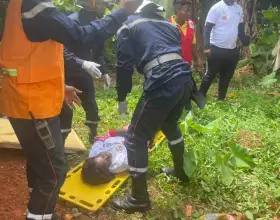UN Condemns Use Of Explosive Device In Central African Republic
After MINUSCA issued a statement on the use of landmines, both the 3R rebel group and Russian mercenaries have denied being responsible.

The United Nations Multidimensional Integrated Stabilization Mission in the Central African Republic (MINUSCA) on Saturday, May 8, condemned the use of explosive engines in the Central African Republic, describing it as a violation of international humanitarian law.
“This cowardly practice is a serious violation of international humanitarian law and exposes its authors to judicial pursuits,” MINUSCA said in a statement.
The MINUSCA statement came 72 hours after a vehicle belonging to the Catholic church in Niem within Bouar diocose in the northwest of the country was damaged by a landmine. Latest reports say at least one person was killed by the blast.
One person also died on Monday, April 5, in a landmine explosion on the passage of a vehicle belonging to the congregation of priests of the Sacred Heart of Jesus in Betharram.
The use of explosive devices is becoming rampant in the armed conflict in the Central African Republic. Recently, there have been reports of landmine explosions in Loyaye in the eastern part of the country, in Haute-Kotto in the north, and in Ouaka situated in the centre of the country.
Few hours after the explosion of the landmine in Niem, Valery Zakharov, the Russian adviser to the Central African Republic Head of State put out a statement blaming the Return, Reclamation, Rehabilitation (3R) rebel movement for having planted mines in the Nana-Mambere region.
Shortly after the publication of the Russian statement, the 3R rebels issued their own statement rejecting the accusations of the Russian adviser to President Touadera.
According to the 3R rebels, “the accusations by the Russian adviser to the head of state are but diversions to eventually hide the crimes which have been committed by Russian mercenaries as revealed by the United Nations in the international media.”
Reliable sources that opted for anonymity last evening informed HumAngle in Bangui that both the Russians and the 3R movement have been using explosive engines in Lobaye, Haute-Kotto, Ouaka, Nana-Mambere and Ouham-Pende.
MINUSCA had last year accused the 3R rebels of planting landmines in Ouham-Pende.
Support Our Journalism
There are millions of ordinary people affected by conflict in Africa whose stories are missing in the mainstream media. HumAngle is determined to tell those challenging and under-reported stories, hoping that the people impacted by these conflicts will find the safety and security they deserve.
To ensure that we continue to provide public service coverage, we have a small favour to ask you. We want you to be part of our journalistic endeavour by contributing a token to us.
Your donation will further promote a robust, free, and independent media.
Donate HereStay Closer To The Stories That Matter




